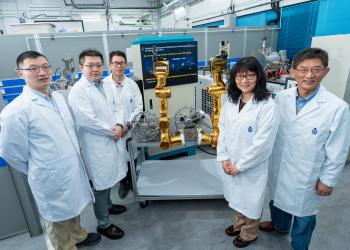Using Sensing Technology for Sustainable Tree Management
“Every tree is a living thing,” says Prof. WANG Yu-Hsing, Associate Head and Professor of the Department of Civil and Environmental Engineering, while admiring a tree on the hillside near HKUST’s waterfront. Typhoon Mangkhut in September 2018 cracked the tree almost in half. Severely damaged, Prof. Wang thought it might not make it, but it did miraculously. What fascinates him most is the tree’s resilience and tenacity in withstanding adverse weather conditions that have become more rampant due to climate change. In order to monitor the tree’s stability, Prof. Wang has installed a smart sensor at its lower trunk to monitor its’ tilting angle.
The sensor mounted on the tree is developed by Prof. Wang and his research team who originally conducted a student-oriented project of using sensing technology on slopes seven years ago.
“As an engineer, we want to find an absolute method to ascertain the health status of a tree,” says TAN Pin Siang, a Civil Engineering postgraduate who’s one of Prof. Wang’s team members. “By studying a tree’s physics, we can accurately assess whether a tree’s tilting is non-reversible and if immediate action is required,” he adds.
They were approached by the Hong Kong government in 2017 to look into the potential adaptation of using the sensing technology on trees. Conventional sensors in the market failed to fulfill the two basic elements required to make tree sensors work: data transmission without interference in extreme weather conditions, and long battery life.
After successfully obtaining external funding for one and a half year beginning February 2018, for developing smart sensing technology to monitor tree stability, Prof. Wang’s team worked tirelessly for a year to eventually achieve a breakthrough in their smart sensor that uses the Low-power, Long-range Wide Area Network (LoRaWAN) for transmitting data in real-time while consuming low energy.
The data would then be sent to the data center for big data analytics and timely interventions. Three generations of sensors have been developed throughout the funding period that quadrupled the data transmission range.
Effective tree management has always been a priority to the Hong Kong authorities as old and valuable trees in the city, being inextricably connected to nature, are prone to damages brought by typhoons, thus pose a high risk to people’s safety.
At the end of August 2018, the Hong Kong Observatory forecasted that Typhoon Mangkhut, the strongest typhoon in Hong Kong history, would sweep the city directly, prompting the team to optimize program design of the sensor and install 32 generation-three sensors on trees in Tai Tong and some urban trees within a week.
Although typhoon Mangkhut left the city with 46,000 fallen trees, it provided the team much valuable first-hand science-based data to analyze how and why certain trees fell and some others survived.
“What we ultimately aim to achieve is let AI provide a more solid diagnosis for tree health,” says Prof. Wang. “Even a tree is seemingly unhealthy, our sensor can continue monitoring it in order to allow it to recover instead of killing it at once.”
The sensors can also ease the heavy workload of the city’s hundreds of arborists. The team will start educating arborists on how to operate the sensors, and in turn, with their feedback, help to fine-tune the device.
After the external funding, Prof. Wang participated in the University’s two-year Sustainable Smart Campus project commencing in July 2019. With this, the team is able to continue developing the fourth generation of the sensor that can harvest energy from solar panels and conduct data analytics by AI.
Prof. Wang credits his project to its origin – HKUST’s student-operated Makerspace which allowed him to embark on this exploration project with his team. In addition to hardware support, Pin Siang thinks what’s most important is HKUST gives them the freedom to explore and try new things, and encourages them to solve everyday problems via technology and innovation.
After years of studying trees, Prof. Wang’s fondness for this amazing species has grown stronger and considered himself a “tree lover”. OOI Ghee Long, one of the team members, supports Prof. Wang’s commitment to protecting as many trees as possible. “Trees are living beings, yet they cannot speak for themselves. They contribute lots to humans, now it’s our term to speak for them,” Ooi says.











